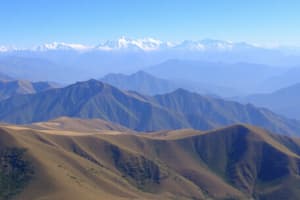Podcast
Questions and Answers
Which rivers drain into the Bay of Bengal from the Peninsular plateau?
Which rivers drain into the Bay of Bengal from the Peninsular plateau?
- Narmada, Tapi, and Mahi
- Godavari, Krishna, and Kaveri (correct)
- Ganges, Yamuna, and Brahmaputra
- Indus, Jhelum, and Chenab
What are the two main features of the Northern plains?
What are the two main features of the Northern plains?
- Alluvial deposits and hilly landscape
- Low elevation and arid conditions
- Undulating terrain and hot, dry climate
- Fertile soil and lush vegetation (correct)
Which minerals are found in the Peninsular plateau?
Which minerals are found in the Peninsular plateau?
- Iron ore, bauxite, and manganese (correct)
- Diamonds, emeralds, and rubies
- Gold, silver, and copper
- Coal, limestone, and iron ore
What causes the formation of the Northern plains?
What causes the formation of the Northern plains?
What is the main source of water for the Northern plains during the monsoon season?
What is the main source of water for the Northern plains during the monsoon season?
What is the Peninsular plateau of India also known as?
What is the Peninsular plateau of India also known as?
What are the main features that border the Peninsular plateau?
What are the main features that border the Peninsular plateau?
What type of rocks largely compose the Peninsular plateau?
What type of rocks largely compose the Peninsular plateau?
What is the general climate of the Peninsular plateau characterized by?
What is the general climate of the Peninsular plateau characterized by?
Which season in the Peninsular plateau brings heavy rainfall to the region?
Which season in the Peninsular plateau brings heavy rainfall to the region?
Flashcards are hidden until you start studying
Study Notes
Physiography of India
India, a country in South Asia, is known for its diverse geography, which includes various physical features such as mountains, plateaus, plains, and coastal regions. In this article, we will explore the physiography of India, focusing on the Peninsular plateau and the Northern plains.
Peninsular Plateau
The Peninsular plateau, also known as the Deccan plateau, is a large region in central India that covers an area of approximately 500,000 square kilometers. It is bordered by the Western and Eastern Ghats on the west and east, respectively, and the Eastern and Western Coastal Plains on the south and north.
The Peninsular plateau is characterized by its undulating terrain, with elevations ranging from 600 to 1,200 meters above sea level. The plateau is largely composed of igneous and metamorphic rocks, which were formed during the Deccan Traps period, a geological era that occurred around 66 to 68 million years ago.
The climate of the Peninsular plateau is generally dry and hot, with temperatures frequently exceeding 40°C in the summer months. The region experiences two main seasons: a dry season from October to May and a monsoon season from June to September. The monsoon season brings heavy rainfall to the region, which is essential for the growth of crops such as rice, wheat, and cotton.
The Peninsular plateau is home to several important rivers, including the Godavari, Krishna, and Kaveri, which flow eastwards and drain into the Bay of Bengal. The region is also rich in minerals, including iron ore, bauxite, and manganese.
Northern Plains
The Northern plains, also known as the Indo-Gangetic plains, are a vast, flat region that stretches from the Himalayas in the north to the Vindhya and Satpura ranges in the south. The plains cover an area of approximately 250,000 square kilometers and are characterized by their fertile soil and lush vegetation.
The Northern plains are formed by the alluvial deposits of the Himalayas, which are carried by the Ganges, Yamuna, and other rivers that flow through the region. The plains are generally flat, with elevations ranging from 150 to 300 meters above sea level.
The climate of the Northern plains is generally hot and humid, with temperatures frequently exceeding 40°C in the summer months. The region experiences three main seasons: a dry season from November to March, a pre-monsoon season from April to May, and a monsoon season from June to September. The monsoon season brings heavy rainfall to the region, which is essential for the growth of crops such as rice, wheat, and sugarcane.
The Northern plains are home to several important rivers, including the Ganges, Yamuna, and Brahmaputra, which flow through the region and drain into the Bay of Bengal and the Arabian Sea. The region is also rich in minerals, including coal, limestone, and iron ore.
In conclusion, the physiography of India is diverse and varied, with the Peninsular plateau and the Northern plains being two of the most prominent features. The Peninsular plateau is characterized by its undulating terrain and hot, dry climate, while the Northern plains are characterized by their fertile soil and lush vegetation. Both regions are essential for the growth of crops and the development of India's economy.
Studying That Suits You
Use AI to generate personalized quizzes and flashcards to suit your learning preferences.




